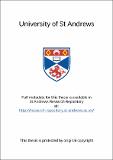Files in this item
A syntax directed translator
Item metadata
| dc.contributor.advisor | Davie, A. J. T. (Antony J. T.), 1939- | en |
| dc.contributor.author | Kadwa, Abdul Khaliq | en |
| dc.coverage.spatial | 172 p | en |
| dc.date.accessioned | 2021-04-08T08:37:34Z | |
| dc.date.available | 2021-04-08T08:37:34Z | |
| dc.date.issued | 1969 | |
| dc.identifier.uri | https://hdl.handle.net/10023/21795 | |
| dc.description.abstract | 'This Thesis describes a program, based on the mechanism discussed by Metcalfe [AL] , which performs indicated operations automatically to check syntax of various source languages and also translates a source language into a pre-determined target language. A mechanism, an improvement on that of Metcalfe or rather not discussed by Metcalfe, which in certain respects will speed up translation is also described. The program written in the IBM 1620 symbolic programming language simulates a special purpose stored-program computer (Syntax machine [AL] ). A program for this machine (syntax program [AL] ) represents the syntax and semantics of some language to be translated. Since the syntax machine can be programmed, it can translate any number of source language-target language pairs, that is it is a parametrized compiler. Two sets of parameters have to be provided for the compiler in order to carry out a specific translation : a specification of the source language and a specification of the target language. Only one set of parameters is required if only syntax checking is to be performed, that is, the specification of the source language. The source language description will be in an expanded form of constituent (phrase-structure) grammar. The target language description will be in a form which is consistent with and embedded in the source language description. This total specification of the source and target languages is referred to as a "grammar", and the notation in which it is written as a "meta-language". Thus the scope of translation is limited to those language pairs which are completely definable by phrase -structure analysis end synthesis. Such analysis can be referred to as "parsing" or analysis in terms of the syntax for a particular grammar. The synthesis is often called "unparsing"' --Taken from Introduction | en |
| dc.language.iso | en | en |
| dc.publisher | University of St Andrews | en |
| dc.subject.lcc | QA264.K2 | |
| dc.subject.lcsh | Programming (Mathematics) | |
| dc.title | A syntax directed translator | en |
| dc.type | Thesis | en |
| dc.type.qualificationlevel | Doctoral | en |
| dc.type.qualificationname | MSc Master of Science | en |
| dc.publisher.institution | The University of St Andrews | en |
| dc.contributor.institution | Mathematics & Statistics Theses | en |
This item appears in the following Collection(s)
Items in the St Andrews Research Repository are protected by copyright, with all rights reserved, unless otherwise indicated.

